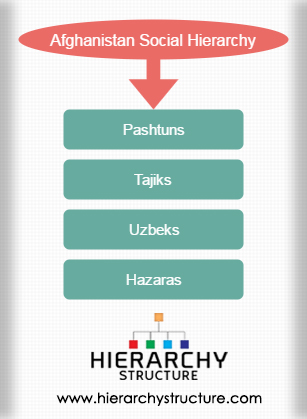Traditionally, the word Afghan has been used to describe an ethnic group, also known as the Pashtuns, yet the country is multicultural. In Afghanistan, there are several ethnic and linguistic groups and also there are several Islamic sects who live in this country and they are organized in a hierarchical structure in the society. The formation of the state of Afghanistan was due to an expansion of Persian tribes. With time, the demographic importance of the Pashtuns has reduced a lot and they are now only 38% of the population. Some other ethnic groups of the country are Uzbeks, Tajiks, and Hazaras.

In the traditional hierarchical system that constitutes the society, there are several groups and subgroups, based on population, power etc. Here is a glimpse of the structure.
- Traditionally Pashtuns were the largest tribe of the country, and as a result of the majoritarian position they could dominate over other tribes of the country. They enjoyed a position of importance as far as governmental jobs go. The governments were also often dominated by members of the Pashtun tribe. They followed the sunni sect of the Islam but are divided into two sub tribes, namely. Durrani and Ghilzai.
- Tajiks are the second largest ethnic group of the country, and are generally people involved in sheep rearing or sedentary mountain agriculture. They have no sub divisions among them and generally, spoke Dari Persian. Their homeland is near Panjeshar valler north of Kabul. They grow exquisite quality of nuts and fruits in different varieties.
- Uzbeks are another important tribes living in the Northern Afghanistan, along with the Tajiks. Their dialect is known as Uzbeki. Just like the Pashtuns they are also Sunni muslims. There are a variety of occupations that the Uzbeks practiced, some are engaged in farming or herding while some others take up arts and crafts to become artisans. Some even become businessmen of repute. They have powerful leaders with titles of Khan and Beg. They are not in favor of having matrimonial relationships with the Pashtuns.
- In the central section of Afghanistan lives the Hazara tribe, and as a result the place is often called Hazarat. The people of Hazara are mostly shepherds and farmers. They are Shia muslims. It is generally understood that their ancestors came from the North Western China, a place named Xinjiang. They have certain distinctive features and often face humiliation due to this particular type of appearance. They belong to the lowest section of the social hierarchy. Most of the Hazaras are illiterate people. Even some people of this tribe work as slaves. They are hugely oppressed by other Afghan people in general.
Apart from the ethnic division, the society is broadly divided on the basis of money too. There is a considerable rift between the rich people and the poor people. It is generally seen that affluent people belong to tribes that are placed higher in the societal ranks like Pashtuns, while Hazaras, and the gypsies belong to the poorer section of the society. This is the basic hierarchical structure of the Afghan society.
